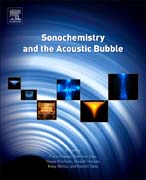
Sonochemistry and the Acoustic Bubble
Grieser, Franz
Choi, Pak-Kon
Enomoto, Naoya
Harada, Hisashi
Okitsu, Kenji
Yasui, Kyuichi
The book provides a beginners introduction to the way ultrasound acts on bubbles in a liquid to cause bubbles to collapse violently, leading to localised 'hot spots' in the liquid with temperatures of 5000 °C and under pressures of several hundred atmospheres. These extreme conditions produce events such as the emission of light, sonoluminescence, with a lifetime of less than a nanosecond, and free radicals that can initiate a host of varied chemical reactions (sonochemistry) in the liquid, all at room temperature. The physics and chemistry behind the phenomena are simply but comprehensively presented. In addition, potential industrial and medical applications of acoustic cavitation and its chemical effects are described and reviewed. The book is suitable for graduate students working with ultrasound and for potential chemists and chemical engineers wanting to understand the basics of how ultrasound acts in a liquid to cause chemical and physical effects. The book is a carefully structured beginners guide to acoustic cavitation phenomena, i.e., the formation and subsequent collapse of micro bubbles in a liquid exposed to ultrasound. Its chemical effects (sonochemistry) are caused by radicals formed inside bubbles during their collapse as a consequence of the extreme temperatures and pressures created within such bubbles. These free radicals are the basis of many chemical reactions, including, electron transfer reactions, new stable compound formation, initiation of polymerization processes, as well as oxidation reactions leading to molecular degradation. The book guides the reader from the physics of how ultrasound interacts with bubbles to applications of sonochemisty. The applications cover industrial (including food processing) and medical uses of ultrasound. It is useful for the user because it consolidates what is known how ultrasound acts on bubbles, and the chemical consequences of its exposure to a broad range of systems. As ultrasound reactors are widely used in both the laboratory and in commercial processes the book provides a useful fundamental understanding on what lies behind the application in action Experimental methods on acoustic cavitation and sonochemistry One can readily begin experiments in the field. Fundamentals One can easily understand the physics behind the phenomenon. Examples of (possible) industrial applications in chemical engineering and environmental technologies One can easily understand the possibilities for adopting the action of acoustic cavitation with respect to industrial applications. Examples of (potential) medical applications One can easily grasp the potential use of the phenomenon to medical applications. Examples in organic and inorganic chemical synthesis One can readily understand the many possibilities for applying cavitation chemistry in chemical synthesis. History One is clearly introduced to the history of the field and its novel developments. INDICE: Chapter 1. Acoustic Field and Bubbles, Chapter 2. Dynamics of Acoustic Bubbles, Chapter 3. Sonochemistry, Chapter 4. Sonoluminescence, Chapter 5. Experimental Methods in Sonochemistry, Chapter 6. Applications in Chemical Engineering, Chapter 7. Applications in Organic Synthesis, Chapter 8. Applications in Inorganic Synthesis, Chapter 9. Bio and Medical Applications, Chapter 10. Applications in Environmental Technologies
- ISBN: 978-0-12-801530-8
- Editorial: Elsevier
- Encuadernacion: Cartoné
- Páginas: 312
- Fecha Publicación: 13/07/2015
- Nº Volúmenes: 1
- Idioma: Inglés
